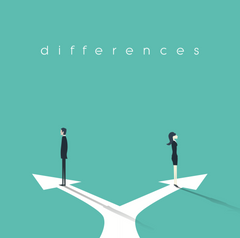Differences Matter!

When it comes to health, there are many crucial differences between men and women.
Yet many women do not know that they react differently to some medications, are more vulnerable to some diseases, and may have different symptoms.
Following are some quick but vital facts about sex differences in health care that you probably did not know.
Nutrition is the number one way to prevent, manage or reduce the risk of disease. Honor our differences and eat like a woman today and every day!
When it comes to health, there are many crucial differences between men and women.
- Women metabolize food and lose weight far differently than men.
- Women taste food differently.
- Women make less serotonin than men increasing the risk for depression.
The Eat Like a Woman food ratios provide lasting energy for women-on-the-go who demand delicious guilt-free nutrition.
The national dietary standards were originally based on the studies of young healthy MALES. Have YOU been eating like a MAN and gaining weight like a woman?
Current diet books present programs for men and women, based on the research results that used men only.
It is no surprise that men get skinny and women get mad!
Eat Like a Woman smart Nutrition Bars and Life Stage Shakes, are inspired by the latest science in women's health.
Our products are all PLANT-BASED, GLUTEN-FREE, Dairy-Free, Soy-Free and made using organic, real food ingredients!
Check out other differences between females and males. How we eat to prevent, reduce risk and manage disease with our food choices is paramount.
Heart Disease
Heart disease kills 500,000 American women each year – over 50,000 more women than men – and strikes women, on average, 10 years later than men. Women are more likely than men to have a second heart attack within a year of the first one.
Depression
Women are two-to-three times more likely than men to suffer from depression. Women are particularly vulnerable to depression and other mood disorders during hormonal transitions in the lifespan (puberty, pregnancy, menopause).
Osteoporosis
Women comprise 80 percent of the population suffering from osteoporosis. Osteoporosis-related fractures are a main cause of disability and mortality in the United States.
Smoking
Smoking-related diseases kill more than 140,000 American women annually. Smoking has a more negative effect on cardiovascular health in women than men. Women are also less successful quitting smoking and have more severe withdrawal symptoms.
Autoimmune Disease
Three out of four people suffering from autoimmune diseases, such as multiple sclerosis, rheumatoid arthritis, and lupus, are women. Autoimmune diseases are in the top 10 leading causes of deaths (age 65 and younger) and are the fourth largest cause of disability among US women.
STIs/HIV
Women are two times more likely than men to contract a sexually transmitted infection. HIV is among the top 10 leading causes of death for all US women aged 25-54 and is the number 1 leading cause of death for African American women aged 25-34.
Stroke
Each year, approximately 40,000 more women than men suffer from a stroke. This is related to women’s greater life expectancy and the higher rates of stroke in the oldest age groups.
Alcohol
About 1.6 million alcoholics in the US are women, who are the fastest growing segment of the alcohol abusing population. Women produce less of the stomach enzyme that breaks down ethanol; therefore, after consuming the same amount of alcohol, women have higher blood alcohol content than men, even after adjusting for size.
Drug Addiction
Women are more likely to experience more severe withdrawal symptoms than men when trying to quit an addictive substance, and generally find it more difficult to quit than men do.
Pain
Many chronic pain conditions are more common in women, such as rheumatoid arthritis, fibromyalgia, migraine, and osteoarthritis (after age 45). Women generally show greater sensitivity to pain than men do.
List provided by SWHR
